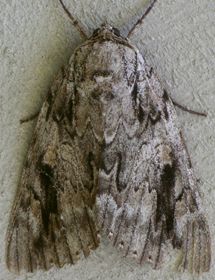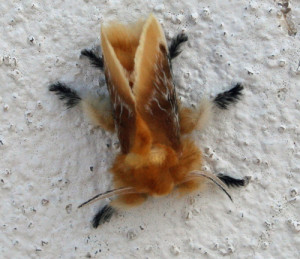I love field guides of all kinds, but because of my profession I especially enjoy insect field guides. I’ve come to appreciate well selected photos or artwork that carefully depict an organism’s key identification characters. There is also a certain aesthetic to a meticulously-posed picture of a series of butterflies, or moths or beetles.
You can recognize a quality posed moth or butterfly by the uniformly spread wings. The trailing edge of the front wing should be perpendicular to the body and the hind wings must be pulled up with just the leading edge hidden. Despite the beauty of the preferred pose in entomology collection boxes, this is not how most Lepidoptera (moths and butterflies) are commonly seen in the field.
Most resting Lepidoptera fold the front and hind wings over one another in a V-shape (especially moths), or sometimes vertically over the body (especially butterflies). Consequently, it’s very difficult to reconcile a resting moth with a typically posed picture in a field guide.

Standard pose of a southern flannel moth adult. Photo by Ray Simpson on BugGuide.net
As an example, compare the accompanying two pictures of a southern flannel moth, Megalopyge opercularis. This is a relatively common moth in Texas, best know perhaps in its larval form as an “asp”, one of our stinging flannel moth caterpillars. I had seen pictures of the adult moth in field guides and always thought them dull until someone (Laura Bellmore from Galveston County) snapped this image (bottom) of the adult moth in its natural resting pose on a wall. What a fantastic creature! With a little help from folks at Bugguide.net, I was soon able to connect it with the dull, drab moth I’d seen pictured in my moth field guide.
This experience gave me a better appreciation of the need for a field guide to moths that would show them in their natural poses. So when Mike Quinn sent a link this week to Val Bugh’s website of noctuid moths, I was immediately hooked. Val has done an incredible job of photographing noctuid moths in natural poses on her extensive website on Austin Bugs (She’s done a lot of other insect groups as well).
As you look at these moths notice the patterns that occur when wings are held in their natural positions. Wavy lines that don’t make much sense in a spread specimen suddenly form logical patterns. Patterns now resemble the shadows of a broken tree branch, or furrows in bark, or lichen. No Texas turkey or deer hunter in full camo could surpass these creatures in their ability to blend in with their surroundings. Notice how these wing scale designs work to break up the moth’s natural silhouette, making them more difficult for a predator (or human) to spot on a natural surface.

Catocala maestosa from Val Bugh's Austin Bug Collection website.
Of course, many of these pictures are taken on man-made surfaces, such as the side of a house. This is where the millions of years of evolution to perfect these optical illusions breaks down. Camouflage sticks out like a sore thumb against a white wall. Fortunately, this makes it easier for our dull eyes to see many of these small wonders of the forest.
The next time you venture outside of a home, hotel or cabin near one of our Texas forests, take a look at the exterior walls, especially walls that may have been lit by artificial light overnight. Chances are good that you’ll spot some of these beautiful insects.
